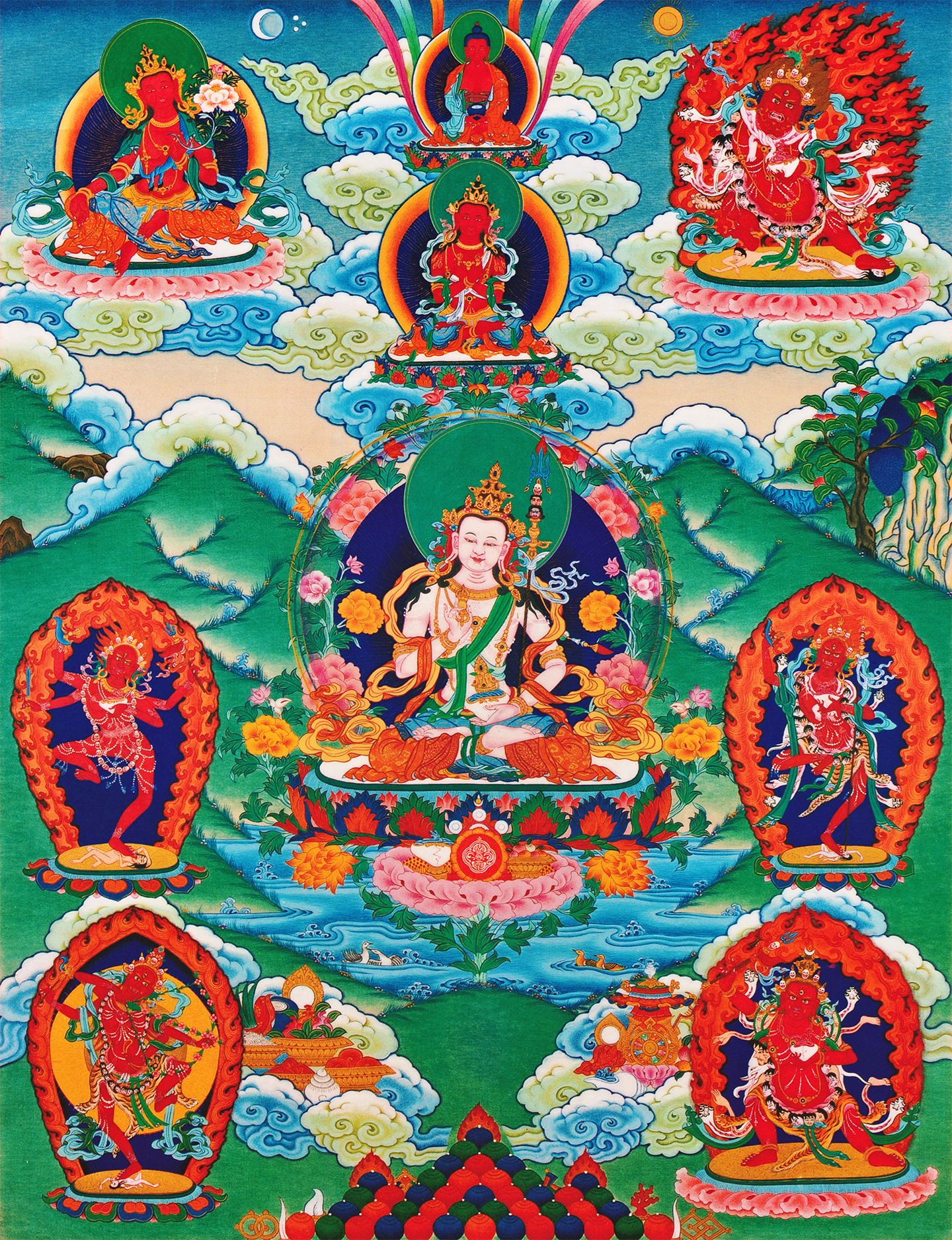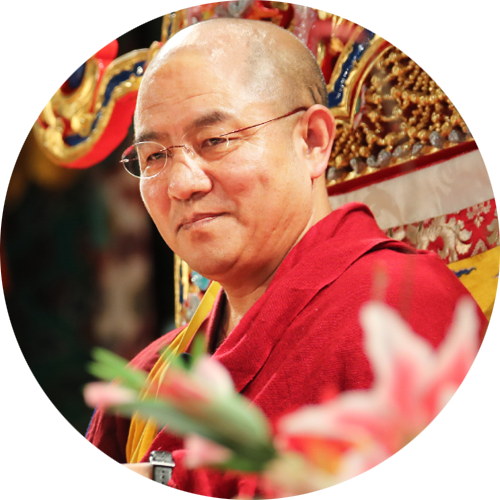Wang Dü: The Great Cloud of Blessings
Even though Wang Dü is not identified as a terma, it is generally understood to have come from Ju Mipham Rinpoche’s wisdom mind, from the great Bodhisattva Manjushri. Wang Dü is an extraordinary prayer that brings within one’s power, all phenomena in the entire universe, while at its most powerful, it bestows the ability to tame one’s mind. Therefore, it can be said to have two main effects: an outer and an inner one. By relying on the prayer, one gains in the outer sense, the ability to benefit all living beings; while its inner effect offers one the ability to control discursive thoughts, and thereby attain unrestrained control of the body and the mind.

Wang Dü is a practice of Vajrayana Buddhism. Usually, the prerequisite for receiving such a teaching is an empowerment. But because it is a prayer, and does not contain explicit Vajrayana practice instructions, and furthermore because many people in Tibet, Han-China and overseas are already chanting this prayer, I think there is no harm to be had from you listening to this teaching. For this reason, I authorize those who have not received an empowerment, if you promise to recite the Vajrasattva mantra 100,000 times, you are permitted to receive this teaching.
Audios (with simultaneous English translation)
The Great Benefits of Wang Dü
Because of these incredible effects, Wang Dü is a highly valued Dharma practice at Larung Gar. Every teaching and every tutorial begins with the recitation of this prayer three times. H. H. Jigme Phuntsok Rinpoche once said, “If I and my future lineage holders want to benefit sentient beings for all future lives, recitation of this prayer is the most effective means.” In order to create favorable conditions for his students to benefit sentient beings, His Holiness made offerings to the sangha at Larung Gar so that they would recite Wang Dü three times every day. This was later increased to five times a day. After His Holiness passed away, Lama Mumtso also made offerings to the sangha to continue the daily recitation.
This prayer is not only popular at Larung Gar. Even outside the institute, one can often see old, white-haired and toothless Tibetans reciting Wang Dü fluently with great vigor. This must surely be a sign of successful magnetizing! As Khenpo Sodargye said, “Although we never made any effort to promulgate the prayer, it has grown spontaneously and is now recited by many domestic and overseas practitioners.”
Resources
The Mandala to Which One Prays
H.H. Jigme Phuntsok Rinpoche once asked an artist to draw the nine deities according to the description in Wang Dü. In the drawing, the Dharmakaya Buddha of Boundless Light (Amitabha) is located at the top in the centre. Amitabha is equivalent to Samantabhadra with the exception that Samantabhadra is generally identified by his blue color, whereas Amitabha is red. Positioned directly below Amitabha is the Sambhogakaya Buddha, Vajradharma, the equivalent of Vajradhara. Below Vajradharma is the Nirmanakaya Padma Gyalpo, an emanation of Padmasambhava. At the top left is red Avalokiteshvara; below that is Guhyajñāna and at the bottom left is Kurukullā. On the top right of Vajradharma is Hayagriva, below that is Vajravarahi and then Mahadeva is on the bottom right.
Resources
The Magnetizing Deities
In Vajrayana, naked representations of Buddha figures symbolize the intrinsic nature of all phenomena. In this samsaric world, normally, a person depicted without clothes is considered shameful. However, in this case, as the nature of all phenomena is devoid of intrinsic existence and the nature of mind is bare naked, from this standpoint, any adornment is not necessary.
Among the nine principal magnetizing deities, apart from Amitabha, a few of the dakinis appear naked as well. From this perspective, Vajrayana is indeed the practice of those with sharp natural capacities. If a person still holds on to the notion of shame, Buddhas and Bodhisattvas merely assume graceful and majestic forms. But if a person has realized the bare naked nature of the mind, where all conceptual thoughts and attachments have ceased to exist, then Buddhas and Bodhisattvas appear in another form.
Resources
How to Pray?
When you chant and practice Wang Dü, you can follow the instructions of the common or advanced tantric practices. Of course, uninitiated practitioners, or practitioners who are foreign to tantric practice can practice Wang Dü using the Sutrayana method. Mipham Rinpoche did not require people to strictly practice this prayer in the way of the generation or perfection stages. As long as we pray to the magnetizing deities with devotion, all animate and inanimate worlds will resonate. This will allow the essence of samsara and nirvana to be gathered into oneself.
For people who are new to dharma practice, the practice of magnetizing would definitely be of benefit. In this degenerate age, people have difficulty truly absorbing the Dharma because they lack inner strength; their path in learning the Dharma is filled with obstacles. If you are one of these people, by practicing magnetizing you will develop inner strength, and be able to bring the Dharma into your mind more easily. Then, no matter what kind of obstacle you encounter, you will be capable of handling it.
Resources
The Accomplishments
Some dismiss this magnetizing activity as nothing more than a myth or a fiction, but the very example of His Holiness Jigme Phuntsok Rinpoche demonstrates how tangible the effects of magnetizing can be. All of his many great accomplishments would not have been possible without his accomplishment of the art of magnetizing. The very fact that so many people come to Larung Gar for dharma study and practice, is the result of his magnetizing activity. No one would come and settle in this freezing land of snow for no reason. As Khenpo Sodargye said in his teaching, “I have personally experienced the effect of magnetizing on myself. Each time I go on a trip, I miss Larung very much. As soon as I finish my business, I am eager to head straight back. This is inseparable from His Holiness’ magnetizing activity.”
So this is a true reflection of the power of magnetizing. At Larung Gar we practice magnetizing every year at the Dharma Assembly of the Awareness Holders. During this time of the year, the mantra of the nine deities will be chanted by the full sangha for half a month. Such a practice taking place in such a large assembly is extremely powerful.
Resources
If you don’t have wealth, Wang Dü can bring you wealth; if you want position, Wang Dü can help you get position. Relying on this prayer, you can gain everything that your heart desires. If however, due to having no control over your mind, you are unable to give rise to bodhicitta, emptiness and other non-worldly accomplishments, reciting Wang Dü with diligence will allow you to gain these qualities with ease.
